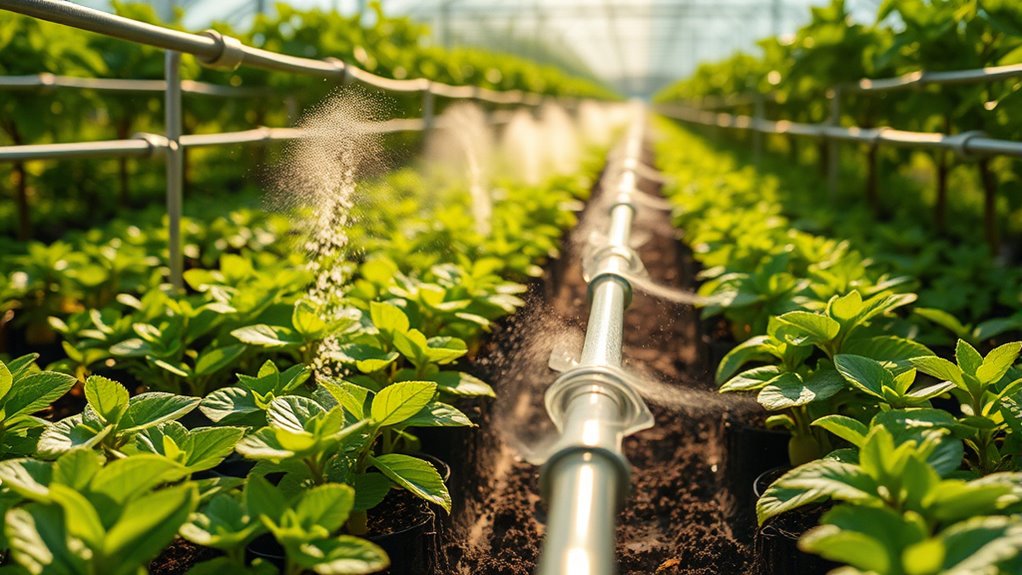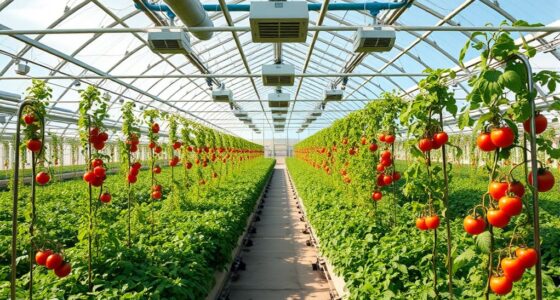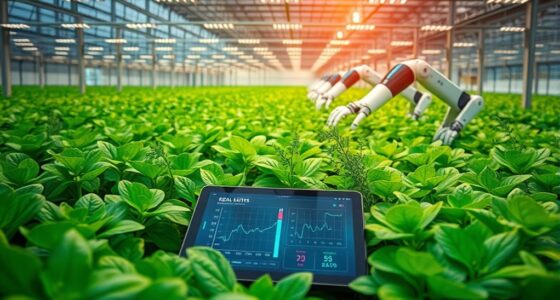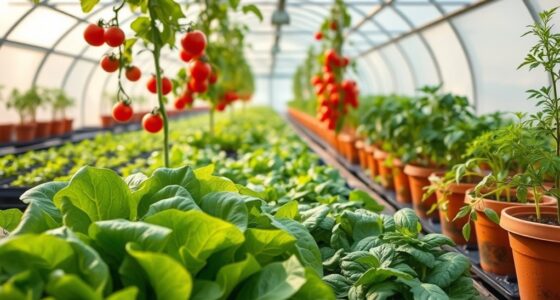Innovative irrigation systems in greenhouses help you maximize water efficiency while boosting crop yields. Technologies like drip irrigation and hydroponics deliver precise water directly to roots, cutting water usage considerably. Automation and smart technology let you monitor conditions in real-time, optimizing your watering schedule for sustainability. By adopting these techniques, you’ll conserve water, lower costs, and improve plant health. Discover more about the benefits and future trends in efficient irrigation systems for your greenhouse.
Key Takeaways
- Drip irrigation delivers water directly to plant roots, minimizing evaporation and runoff for enhanced efficiency.
- Automated systems with IoT-connected sensors optimize watering schedules based on real-time soil moisture and weather data.
- Hydroponics significantly reduces water usage by utilizing nutrient-rich solutions instead of traditional soil methods.
- Implementing rainwater harvesting systems decreases reliance on external water sources, promoting sustainability in greenhouse operations.
- Regular system maintenance and monitoring water quality prevent clogs and ensure efficient water delivery to plants.
Benefits of Efficient Irrigation Systems
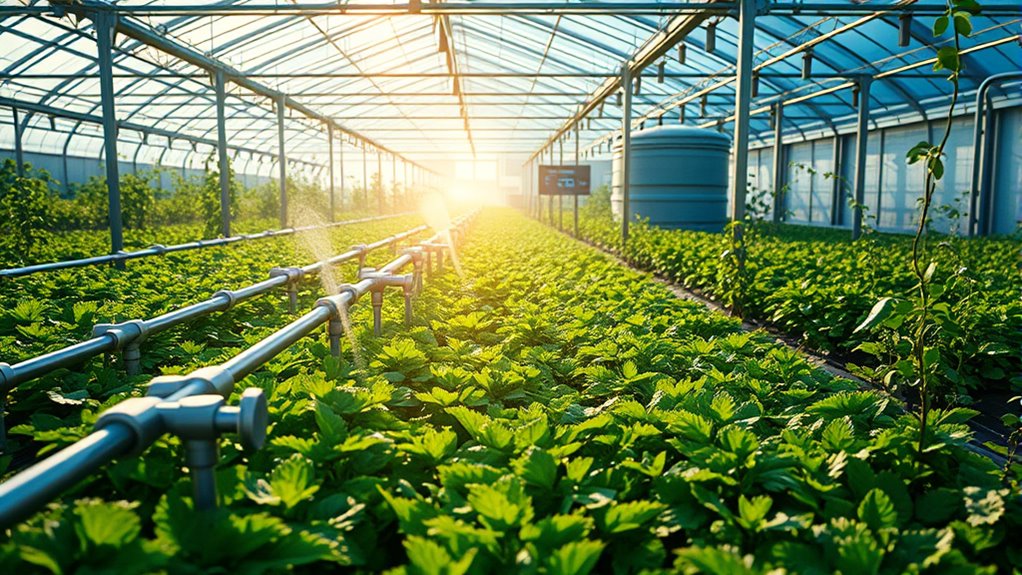
When you implement efficient irrigation systems in your greenhouse, you release a range of significant benefits that can transform your farming practices.
First, you’ll conserve water, saving up to 50% compared to traditional methods. This not only cuts costs but also promotes sustainability. Greenhouse gardening typically requires less water due to its controlled environment and advanced techniques. Additionally, maintaining color accuracy in your irrigation system can enhance plant health and growth. Furthermore, the use of natural elements in your greenhouse design can create a more tranquil environment for plants.
With precise water delivery, you can boost your crop yield by up to 50%, enhancing your overall productivity. Furthermore, using solar-powered irrigation systems can enhance crop yields and efficiency while reducing energy costs.
Additionally, efficient systems reduce evaporation, keeping moisture where it’s needed most.
By minimizing overwatering and underwatering, your plants thrive, leading to improved health and resilience.
As you optimize water usage, you also lower energy costs related to heating and treating water, allowing for a more economically viable operation while fostering a healthier environment.
Types of Innovative Irrigation Technologies

Efficient irrigation systems not only save water and enhance crop yields but also open the door to innovative technologies that optimize how you manage your greenhouse.
Drip irrigation delivers water directly to plant roots, minimizing evaporation and runoff. Hydroponics uses nutrient-rich solutions, greatly cutting down water usage. Additionally, energy-efficient systems like heat pumps can complement these irrigation methods by ensuring optimal climate control within the greenhouse. These advancements contribute to sustainable agriculture practices, which are crucial for long-term food security.
Ebb and flow systems periodically flood and drain growing trays, conserving water effectively. Rainwater harvesting allows you to collect and store rainwater, reducing your reliance on municipal supplies.
Sensor-driven irrigation, equipped with soil moisture sensors, fine-tunes your watering schedules for maximum efficiency. Moreover, the introduction of modern systems utilizing sensors and automation ensures that watering is customized based on real-time environmental conditions. This precision not only enhances water efficiency but also leads to increased crop yields and resource management.
Addressing Challenges in Greenhouse Irrigation
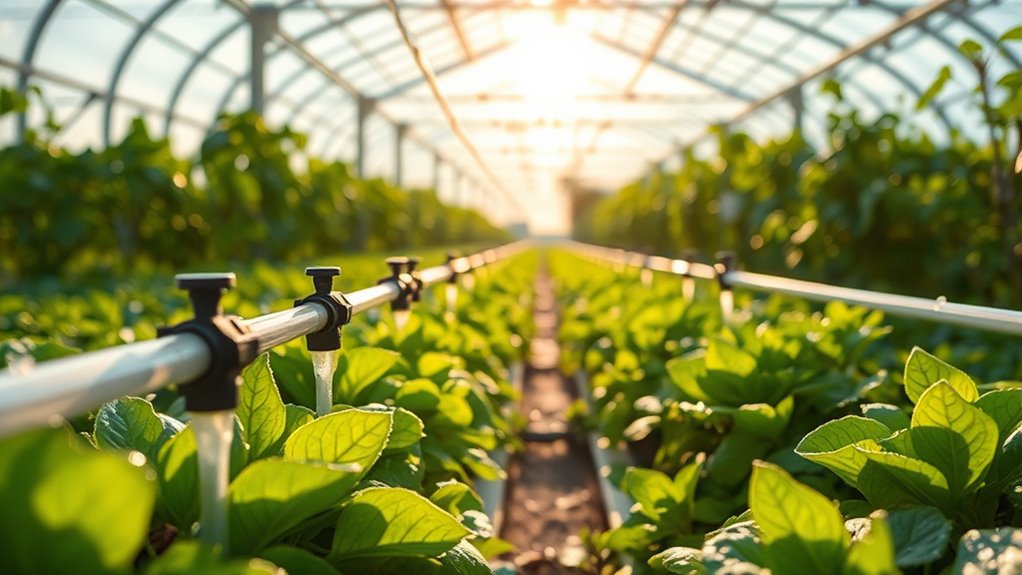
While innovative irrigation systems offer numerous benefits, they also present unique challenges that greenhouse managers must address to maintain ideal plant health and productivity. Clogging is a common issue, whether from physical debris or biological buildup, affecting water flow. You need to guarantee water efficiency to minimize waste and enhance growth, which requires regular system maintenance. Awareness of clogging symptoms is crucial for effective management to ensure timely interventions. Monitoring water quality is essential to prevent salinity and other detrimental effects on plants, especially in well-drained, rich soil that supports optimal growth. Additionally, controlling environmental factors like temperature and humidity is critical; improper management can lead to diseases and inefficient water use. Implementing strategies like regular system flushing, dripper inspections, and optimized irrigation scheduling can help you tackle these challenges effectively, assuring a thriving greenhouse environment. Furthermore, understanding advance directives can provide peace of mind in planning for unforeseen circumstances that may affect greenhouse operations. Additionally, utilizing HEPA filters in air purification can enhance overall plant health by maintaining optimal air quality in the greenhouse environment.
Materials and Designs for Modern Irrigation Systems
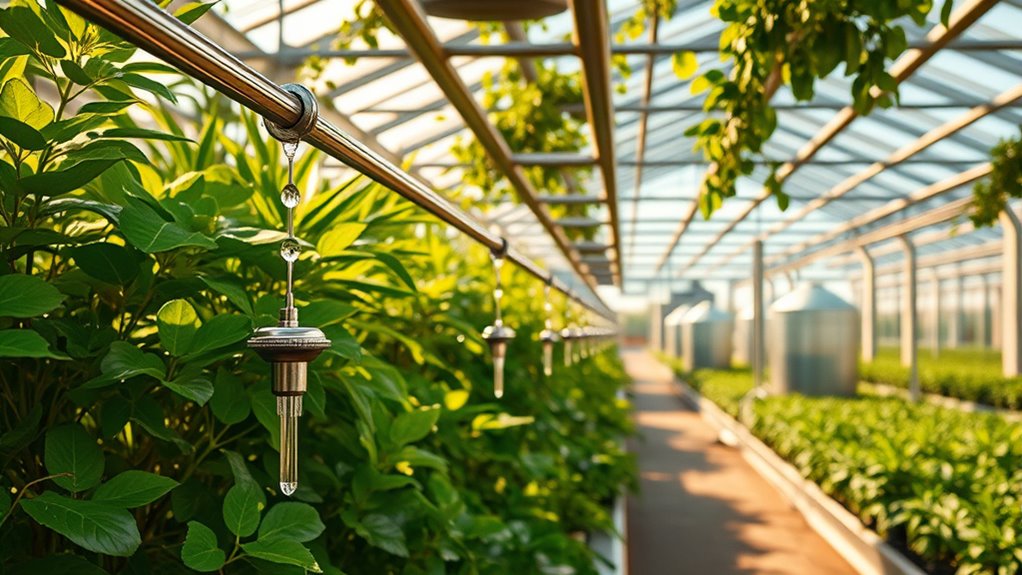
As greenhouse managers seek to optimize water usage, understanding the materials and designs of modern irrigation systems becomes essential.
Drip irrigation components like tubing, valves, and emitters deliver water precisely to plant roots, minimizing waste. This system also offers high water and labor efficiency, significantly enhancing the overall productivity of greenhouse operations. Additionally, using folate-rich plants can support healthy growth in your greenhouse environment. Mindful consumption of resources and materials can further improve irrigation practices and sustainability efforts. Incorporating emergency preparedness essentials into your irrigation planning can help ensure resilience during unexpected water shortages.
Micro-sprinklers made from durable plastics offer uniform coverage while enhancing air circulation.
Soaker hoses, crafted from permeable materials, allow water to seep slowly, and ollas made of unglazed terracotta release water as the soil dries.
For subsurface drip systems, underground pipes with micro-pores help reduce evaporation.
Each design maximizes efficiency, ensuring your plants receive just the right amount of water while conserving resources and improving crop yields.
Adapting these materials and designs to your greenhouse can greatly impact your irrigation success.
The Role of Automation and Smart Technology
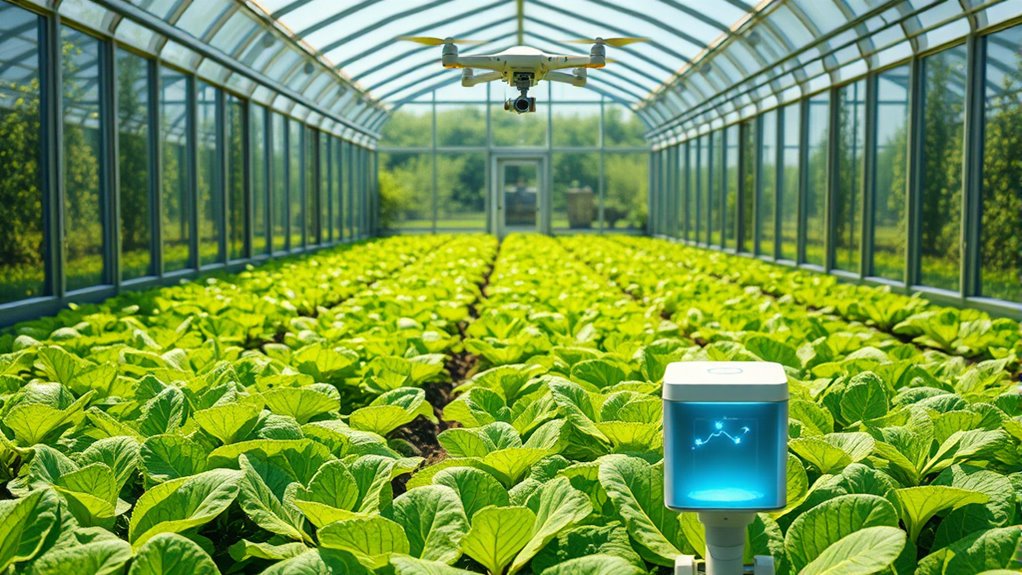
Modern irrigation systems have laid the groundwork for integrating automation and smart technology in greenhouse management. By utilizing IoT-connected sensors, you can monitor soil moisture, temperature, and light levels, adjusting irrigation in real-time. This precision reduces water consumption by 70-98%, ensuring resources are used efficiently. Automated systems not only lower labor costs but also deliver consistent watering, enhancing crop quality and reducing disease risks. You can control these systems remotely via smartphones, offering flexibility and convenience. Real-time data analysis helps you adapt to changing weather conditions, optimizing both water and energy use. Precision agriculture enhances farm efficiency, making it essential for creating a more sustainable and productive greenhouse environment. Furthermore, the incorporation of advanced technology in irrigation systems can lead to better overall resource management and crop yield. Additionally, incorporating rainwater capture techniques can further improve water efficiency by utilizing natural resources for irrigation. Adopting these smart irrigation solutions enables you to create a more sustainable and productive greenhouse environment, similar to how sugar overload from certain candies can lead to health issues when not managed properly.
Future Trends in Irrigation Practices
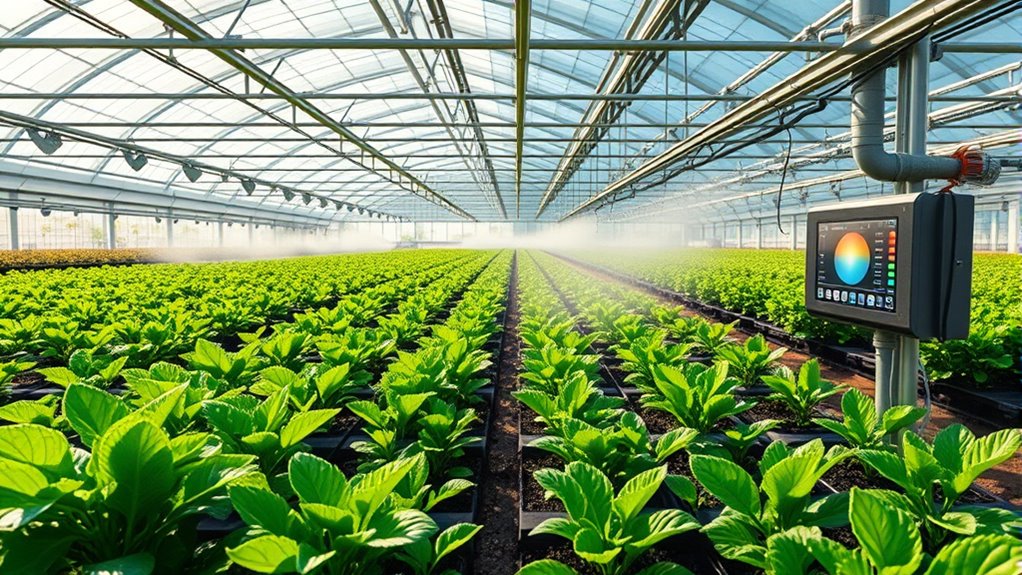
Looking ahead, innovative irrigation practices are poised to revolutionize greenhouse management, making it more efficient and sustainable.
You’ll see a rise in precision irrigation techniques like drip irrigation and hydroponics, which deliver water directly to plant roots and recycle water, cutting waste to less than 10%. Additionally, the adoption of emerging technologies will enhance irrigation systems’ capabilities and performance. The use of self-watering planters can also complement these techniques by providing consistent moisture levels. Furthermore, understanding emotional dysregulation can help greenhouse managers maintain a calm environment, especially during peak operational times.
Soil moisture monitoring and fertigation will become standard, ensuring plants receive ideal nutrients and hydration. The integration of smart irrigation technologies will further optimize water usage by adjusting schedules based on real-time data.
Soil moisture monitoring and fertigation are essential for providing optimal nutrients and hydration to plants.
Closed-loop systems and rainwater harvesting will further enhance sustainability, while IoT integration will streamline operations.
As the greenhouse irrigation market grows, driven by demand for fresh produce, expect automation and data analytics to enhance performance.
These advancements won’t only improve water efficiency but also elevate crop quality and reduce environmental impact.
Sustainable Water Management Strategies
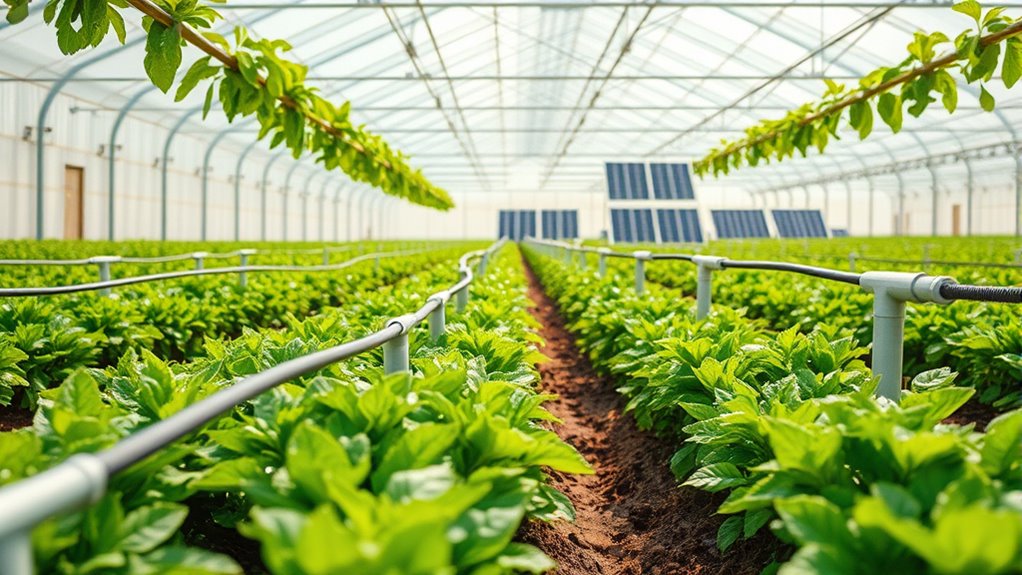
Innovative irrigation practices are paving the way for sustainable water management strategies in greenhouses. You can greatly enhance water efficiency by implementing techniques like drip and sub-irrigation, which deliver water directly to plant roots, minimizing waste. Additionally, natural ventilation can further optimize water usage by reducing the need for excessive irrigation through improved climate control. Transitioning pets to raw food should be done gradually, as it helps avoid digestive issues and aligns with the principles of sustainability in resource management. Rainwater harvesting is another effective method that reduces reliance on external sources; simply collect rainwater using gutters and UV-resistant storage tanks. Furthermore, utilizing eco-friendly wood stoves can contribute to a more sustainable greenhouse environment by providing a renewable heating source. Additionally, recycling water through recirculation systems not only conserves resources but also allows for better nutrient management. Implementing integrated pest management can also reduce water usage by minimizing the need for chemical applications that can contaminate water supplies.
Frequently Asked Questions
How Do I Choose the Right Irrigation System for My Greenhouse?
Choosing the right irrigation system for your greenhouse involves considering several factors.
First, think about your crop type and its water needs. Evaluate your climate conditions, as warmer areas may require more efficient systems.
Factor in your budget for initial investment and maintenance. Also, consider automation to reduce labor.
Finally, assess your soil type, as it influences water absorption.
What Maintenance Is Required for Drip Irrigation Systems?
Imagine your garden as a delicate orchestra, where each plant plays its part. To keep this harmony, you need to maintain your drip irrigation system.
Regularly check for leaks, clean emitters, and flush the system to prevent clogs. Inspect filters and valves to guarantee everything works smoothly.
Just like tuning an instrument, consistent maintenance keeps your plants thriving and your water use efficient—making your garden sing beautifully all season long.
Can I Integrate Multiple Irrigation Systems in One Greenhouse?
Absolutely, you can integrate multiple irrigation systems in one greenhouse!
By combining drip and misting systems, for example, you’ll enhance flexibility and efficiency. Zoning different areas allows you to tailor water delivery based on specific crop needs.
Plus, integrating with environmental controls automates the process, ensuring ideal conditions.
Just make sure you consider the necessary components, like pressure regulators and drainage systems, to maintain performance and prevent issues down the line.
How Does Soil Type Affect Irrigation Efficiency?
Soil type greatly affects irrigation efficiency.
If you’re working with clay soil, you’ll notice it absorbs water slowly but retains moisture well, requiring longer irrigation sessions.
On the other hand, sandy soil drains quickly, so you’ll need to water more frequently to prevent drought stress.
Understanding these characteristics helps you tailor your irrigation strategy, ensuring your crops get the right amount of water without waste.
Adjusting your approach based on soil type is essential for success.
What Are Common Mistakes to Avoid With Greenhouse Irrigation?
You wouldn’t want to drown your plants in a swimming pool of water, right?
Avoiding common mistakes in greenhouse irrigation is essential. Make sure you’re regularly maintaining the system to prevent clogs and monitor water pressure.
Don’t forget to check flow rates and design your system properly to prevent overwatering or underwatering.
Finally, consider automating your irrigation but keep an eye on it to optimize efficiency and plant health.
Conclusion
In closing, embracing efficient irrigation systems can truly transform your greenhouse. By adopting advanced technologies and smart solutions, you’re not just conserving water—you’re cultivating a sustainable future. Remember, every drop counts, so let’s commit to clever conservation. As you explore innovative ideas, you’ll reveal untapped potential, ensuring your plants flourish while protecting precious resources. Together, let’s foster a flourishing future through focused irrigation practices that maximize both growth and green initiatives!
